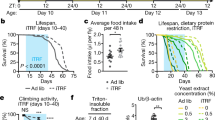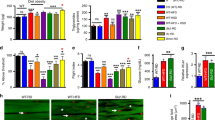Abstract
Diet restriction is one of the most accurately confirmed interventions which extend lifespan. Genes coding circadian core clock elements are known to be the key controllers of cell metabolism especially in aging aspect. The molecular mechanisms standing behind the phenomenon of diet-restriction-mediated life extension are connected to circadian clock either. Here we investigate the effects of protein-rich and low-protein diets on lifespan observed in fruit flies overexpressing core clock genes (cry, per, Clk, cyc and tim). The majority of core clock genes being upregulated in peripheral tissues (muscles and fat body) on protein-rich diet significantly decrease the lifespan of male fruit flies from 5 to 61%. Nevertheless, positive increments of median lifespan were observed in both sexes, males overexpressing cry in fat body lived 20% longer on poor diet. Overexpression of per also on poor medium resulted in life extension in female fruit flies. Diet restriction reduces mortality caused by overexpression of core clock genes. Cox-regression model revealed that diet restriction seriously decreases mortality risks of flies which overexpress core clock genes. The hazard ratios are lower for flies overexpressing clock genes in fat body relatively to muscle-specific overexpression. The present work suggests a phenomenological view of how two peripheral circadian oscillators modify effects of rich and poor diets on lifespan and hazard ratios.


Similar content being viewed by others
References
Armstrong AR, Laws KM, Drummond-Barbosa D (2014) Adipocyte amino acid sensing controls adult germline stem cell number via the amino acid response pathway and independently of Target of Rapamycin signaling in Drosophila. Development 141:4479–4488
Arthaut LD, Jourdan N, Mteyrek A, Procopio M, El-Esawi M, d’Harlingue A, Bouchet PE, Witczak J, Ritz T, Klarsfeld A, Birman S, Usselman RJ, Hoecker U, Martino CF, Ahmad M (2017) Blue-light induced accumulation of reactive oxygen species is a consequence of the Drosophila cryptochrome photocycle. PLoS ONE 12:e0171836
Breslow N (1970) A generalized Kruskal–Wallis test for comparing K samples subject to unequal patterns of censorship. Biometrika 57(3):579–594
Chaves I, van der Horst GT, Schellevis R, Nijman RM, Koerkamp MG, Holstege FC, Smidt MP, Hoekman MF (2014) Insulin-FOXO3 signaling modulates circadian rhythms via regulation of clock transcription. Curr Biol 24:1248–1255
Doi M, Hirayama J, Sassone-Corsi P (2006) Circadian regulator CLOCK is a histone acetyltransferase. Cell 125:497-508
Fontana L, Partridge L, Longo VD (2010) Extending healthy life span—from yeast to humans. Science 328:321–326
Goda T, Mirowska K, Currie J, Kim M-H, Rao NV, Bonilla G, Wijnen H (2011) Adult circadian behavior in Drosophila requires developmental expression of cycle, but not period. PLoS Genet 7:e1002167
Graveley BR, Brooks AN, Carlson JW, Duff MO, Landolin JM, Yang L, Artieri CG, van Baren MJ, Boley N, Booth BW, Brown JB, Cherbas L, Davis CA, Dobin A, Li R, Lin W, Malone JH, Mattiuzzo NR, Miller D, Sturgill D, Tuch BB, Zaleski C, Zhang D, Blanchette M, Dudoit S, Eads B, Green RE, Hammonds A, Jiang L, Kapranov P, Langton L, Perrimon N, Sandler JE, Wan KH, Willingham A, Zhang Y, Zou Y, Andrews J, Bickel PJ, Brenner SE, Brent MR, Cherbas P, Gingeras TR, Hoskins RA, Kaufman TC, Oliver B, Celniker SE (2011) The developmental transcriptome of Drosophila melanogaster. Nature 471:473–479
Hardin PE, Yu W (2006) Circadian transcription: passing the HAT to CLOCK. Cell 125:424–426
Hirayama J, Sahar S, Grimaldi B, Tamaru T, Takamatsu K, Nakahata Y, Sassone-Corsi P (2007) CLOCK-mediated acetylation of BMAL1 controls circadian function. Nature 450:1086–1090
Holloszy JO, Schechtman KB (1991) Interaction between exercise and food restriction: effects on longevity of male rats. J Appl Physiol 70:1529–1535
Kapahi P, Kaeberlein M, Hansen M (2017) Dietary restriction and lifespan: lessons from invertebrate models. Ageing Res Rev 39:3–14
Katewa SD, Kapahi P (2011) Role of TOR signaling in aging and related biological processes in Drosophila melanogaster. Exp Gerontol 46:382–390
Katewa SD, Demontis F, Kolipinski M, Hubbard A, Gill MS, Perrimon N, Melov S, Kapahi P (2012) Intramyocellular fatty-acid metabolism plays a critical role in mediating responses to dietary restriction in Drosophila melanogaster. Cell Metab 16:97–103
Katewa SD, Akagi K, Bose N, Rakshit K, Camarella T, Zheng X, Hall D, Davis S, Nelson CS, Brem RB (2016) Peripheral circadian clocks mediate dietary restriction-dependent changes in lifespan and fat metabolism in Drosophila. Cell Metab 23:143–154
Khapre RV, Kondratova AA, Patel S, Dubrovsky Y, Wrobel M, Antoch MP, Kondratov RV (2014) BMAL1-dependent regulation of the mTOR signaling pathway delays aging. Aging (Albany NY) 6:48
Kumar S, Chen D, Sehgal A (2012) Dopamine acts through Cryptochrome to promote acute arousal in Drosophila. Genes Dev 26:1224–1234
Livak KJ, Schmittgen TD (2001) Analysis of relative gene expression data using real-time quantitative PCR and the 2−ΔΔCT Method. Methods 25:402–408
Moskalev A, Vaiserman AM (2017) Epigenetics of aging and longevity. Elsevier Science, Amsterdam
Moskalev A, Anisimov V, Aliper A, Artemov A, Asadullah K, Belsky D, Baranova A, de Grey A, Dixit VD, Debonneuil E, Dobrovolskaya E, Fedichev P, Fedintsev A, Fraifeld V, Franceschi C, Freer R, Fulop T, Feige J, Gems D, Gladyshev V, Gorbunova V, Irincheeva I, Jager S, Jazwinski SM, Kaeberlein M, Kennedy B, Khaltourina D, Kovalchuk I, Kovalchuk O, Kozin S, Kulminski A, Lashmanova E, Lezhnina K, Liu GH, Longo V, Mamoshina P, Maslov A, Pedro de Magalhaes J, Mitchell J, Mitnitski A, Nikolsky Y, Ozerov I, Pasyukova E, Peregudova D, Popov V, Proshkina E, Putin E, Rogaev E, Rogina B, Schastnaya J, Seluanov A, Shaposhnikov M, Simm A, Skulachev V, Skulachev M, Solovev I, Spindler S, Stefanova N, Suh Y, Swick A, Tower J, Gudkov AV, Vijg J, Voronkov A, West M, Wagner W, Yashin A, Zemskaya N, Zhumadilov Z, Zhavoronkov A (2017) A review of the biomedical innovations for healthy longevity. Aging (Albany NY) 9:7–25
Nakahata Y, Grimaldi B, Sahar S, Hirayama J, Sassone-Corsi P (2007) Signaling to the circadian clock: plasticity by chromatin remodeling. Curr Opin Cell Biol 19:230–237
Oishi K, Shiota M, Sakamoto K, Kasamatsu M, Ishida N (2004) Feeding is not a more potent Zeitgeber than the light-dark cycle in Drosophila. NeuroReport 15:739–743
Osterwalder T, Yoon KS, White BH, Keshishian H (2001) A conditional tissue-specific transgene expression system using inducible GAL4. Proc Natl Acad Sci USA 98:12596–12601
Peschel N, Helfrich-Förster C (2011) Setting the clock—by nature: circadian rhythm in the fruitfly Drosophila melanogaster. FEBS Lett 585:1435–1442
Poirier L, Shane A, Zheng J, Seroude L (2008) Characterization of the Drosophila gene-switch system in aging studies: a cautionary tale. Aging Cell 7:758–770
Prentice RL (1992) Introduction to Cox (1972) regression models and life-tables. In: Kotz S, Johnson NL (eds) Breakthroughs in statistics: methodology and distribution. Springer, New York, pp 519–526
R Core Team (2013) R: a language and environment for statistical computing. R Foundation for Statistical Computing, Vienna. http://www.R-project.org/
Rakshit K, Krishnan N, Guzik EM, Pyza E, Giebultowicz JM (2012) Effects of aging on the molecular circadian oscillations in Drosophila. Chronobiol Int 29:5–14
Roman G, Endo K, Zong L, Davis RL (2001) P{Switch}, a system for spatial and temporal control of gene expression in Drosophila melanogaster. Proc Natl Acad Sci USA 98:12602–12607
Russell RC, Yuan HX, Guan KL (2014) Autophagy regulation by nutrient signaling. Cell Res 24:42–57
Santos J, Leitão-Correia F, Sousa MJ, Leão C (2016) Dietary restriction and nutrient balance in aging. Oxid Med Cell Longev 2016:4010357
Skorupa DA, Dervisefendic A, Zwiener J, Pletcher SD (2008) Dietary composition specifies consumption, obesity, and lifespan in Drosophila melanogaster. Aging Cell 7:478–490
Solovev I, Shaposhnikov M, Kudryavtseva A, Moskalev A (2018) Drosophila melanogaster as a model for studying the epigenetic basis of aging. In: Moskalev A, Vaiserman AM (eds) Epigenetics of aging and longevity. Elsevier, Amsterdam, pp 293–307
Solovyov I, Dobrovol’skaya E, Moskalev A (2016) Genetic control of circadian rhythms and aging. Russ J Genet 52:343–361
Ulgherait M, Chen A, Oliva M, Kim H, Canman J, Ja W, Shirasu-Hiza M (2016) Dietary restriction extends the lifespan of circadian mutants tim and per. Cell Metab 24:763–764
Wang C, Li Q, Redden DT, Weindruch R, Allison DB (2004) Statistical methods for testing effects on “maximum lifespan”. Mech Ageing Dev 125:629–632
Yang Z, Sehgal A (2001) Role of molecular oscillations in generating behavioral rhythms in Drosophila. Neuron 29:453–467
Zhao J, Kilman VL, Keegan KP, Peng Y, Emery P, Rosbash M, Allada R (2003) Drosophila clock can generate ectopic circadian clocks. Cell 113:755–766
Zid BM, Rogers AN, Katewa SD, Vargas MA, Kolipinski MC, Lu TA, Benzer S, Kapahi P (2009) 4E-BP extends lifespan upon dietary restriction by enhancing mitochondrial activity in Drosophila. Cell 139:149–160
Acknowledgements
We are grateful to Dr. Patrick Emery (University of Massachusetts Medical School, USA), Dr. Paul Hardin (Texas A&M University, USA), Dr. Keshishian (Yale University, USA), Dr. Laurent Seroude (Queen’s University, Canada) and the Bloomington stock center (Indiana University, USA) for providing the Drosophila strains.
Funding
The study was carried out within the framework of the state task on themes “Molecular-genetic mechanisms of aging, lifespan, and stress resistance of Drosophila melanogaster”, state registration No. AAAA-A18-118011120004-5 and “A combination of factors of different nature (low temperature, lack of lighting, restrictive diet, and geroprotector) to maximize the lifespan of Drosophila. Complex UrB RAS Programme” No. 18-7-4-23, state registration No. AAAA-A18-118011120008-3.
Author information
Authors and Affiliations
Corresponding author
Ethics declarations
Conflict of interest
The authors have no potential conflicts of interest with respect to the research, authorship, and/or publication of this article.
Electronic supplementary material
Below is the link to the electronic supplementary material.
Rights and permissions
About this article
Cite this article
Solovev, I., Shegoleva, E., Fedintsev, A. et al. Circadian clock genes’ overexpression in Drosophila alters diet impact on lifespan. Biogerontology 20, 159–170 (2019). https://doi.org/10.1007/s10522-018-9784-2
Received:
Accepted:
Published:
Issue Date:
DOI: https://doi.org/10.1007/s10522-018-9784-2




